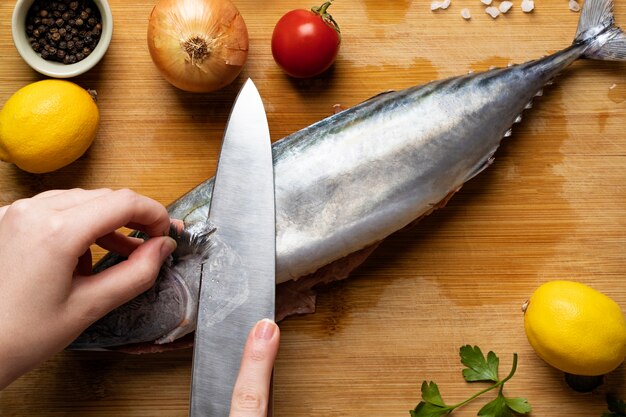
Eat Marlin, a popular and prized fish among anglers and seafood lovers alike, has captured attention for its size, speed, and culinary potential. This article will explore whether marlin is safe to eat, its nutritional benefits, preparation methods, and more.

What is Marlin?
Overview of Marlin Species
Marlin refers to several species of large fish that belong to the family Istiophoridae. They are highly sought after in sport fishing due to their incredible strength and speed. The most common species include:

- Blue Marlin: Known for its striking blue color and impressive size, it can weigh up to 1,800 pounds and is commonly found in tropical and subtropical waters.
- Black Marlin: Recognized for its powerful fighting ability, this species can grow over 1,000 pounds and is often caught in the Indian and Pacific Oceans.
- Striped Marlin: Smaller than its blue and black counterparts, the striped marlin is known for its distinctive vertical stripes and is a popular target for both recreational and commercial fishing.
Habitat and Distribution
Marlin are typically found in warmer ocean waters, primarily in the Atlantic and Pacific Oceans. They prefer deep waters but can often be spotted near the surface, especially during feeding.
Is Marlin Safe to Eat?
Mercury Levels in Marlin
One of the primary concerns when consuming marlin is its mercury content. Like many large predatory fish, marlin can accumulate high levels of mercury in their bodies over time. Mercury is a toxic heavy metal that can pose health risks to humans, particularly pregnant women and young children. The FDA and EPA recommend limiting consumption of high-mercury fish, including Eat Marlin

Health Risks and Recommendations
While the health risks associated with mercury consumption are concerning, eating marlin occasionally and in moderation is generally considered safe for most adults Eat Marlin . The FDA suggests:
- Pregnant women, nursing mothers, and young children should avoid consuming marlin and other high-mercury fish.
- Adults can safely consume marlin once every two weeks to minimize the risk of mercury exposure.
Nutritional Benefits of Marlin
Rich Source of Protein
Marlin is an excellent source of high-quality protein, making it an attractive option for those looking to increase their protein intake. A 3-ounce serving of cooked marlin provides approximately 20 grams of protein, essential for muscle repair, immune function, and overall health Eat Marlin .
Omega-3 Fatty Acids
Marlin also contains omega-3 fatty acids, which are beneficial for heart health. Omega-3s are known to reduce inflammation, lower blood pressure, and support brain health. Although the levels in marlin are not as high as in fatty fish like salmon, they still provide health benefits Eat Marlin .
Vitamins and Minerals
Marlin is rich in essential vitamins and minerals, including:
- Vitamin B12: Important for nerve function and the production of red blood cells.
- Selenium: An antioxidant that supports immune function and protects cells from damage.
- Phosphorus: Essential for bone health and energy production.
How to Prepare and Cook Marlin

Common Cooking Methods
Eat Marlin can be prepared and cooked in various ways, depending on personal preference. Some popular cooking methods include:
- Grilling: Marlin fillets can be marinated and grilled for a smoky flavor. The fish’s firm texture holds up well on the grill.
- Baking: Baking marlin with herbs and spices allows for a healthier cooking option while preserving its natural flavors.
- Searing: Quickly searing marlin steaks in a hot skillet results in a delicious crust while keeping the interior moist.
- Ceviche: Marlin can also be used in ceviche, where it is marinated in citrus juice and served cold with fresh vegetables.
Flavor Pairings
Marlin has a mild, slightly sweet flavor, making it versatile in various dishes. It pairs well with:
- Citrus: Lemon, lime, and orange enhance marlin’s natural sweetness.
- Herbs: Fresh herbs like cilantro, parsley, and basil complement its flavor.
- Spices: Spices like paprika, cumin, and garlic can add depth to marlin dishes.
Tips for Cooking Marlin
- Do Not Overcook: Marlin is best when cooked to medium doneness. Overcooking can lead to a dry texture.
- Marinate for Flavor: A simple marinade of olive oil, lemon juice, garlic, and herbs can enhance the fish’s flavor.
- Use a Meat Thermometer: Aim for an internal temperature of 145°F (63°C) for perfectly cooked marlin.
Where to Buy Marlin
Fresh vs. Frozen

Marlin can be purchased fresh or frozen, depending on availability. Fresh marlin is often available at fish markets, grocery stores, and seafood distributors. Frozen marlin can be found in the freezer sections of many supermarkets, making it a convenient option for home cooks.
Sustainable Sourcing
When purchasing marlin, consider sustainability. Overfishing has significantly impacted marlin populations, leading to concerns about their conservation status. Look for suppliers that practice sustainable fishing methods and check for certifications like the Marine Stewardship Council (MSC) label.
Local Fisheries and Markets
Local fisheries and fish markets can be great sources for fresh marlin. Building a relationship with your local fishmonger can also provide insights into the best times to buy seasonal fish and recommendations for preparation.
Conclusion
In summary, marlin can be a delicious and nutritious addition to your diet, provided you consume it in moderation and are mindful of its mercury content. This versatile fish can be prepared in various ways, making it a favorite among seafood enthusiasts. Always consider sustainable sourcing options when purchasing marlin to support the conservation of fish populations. Whether grilled, baked, or made into ceviche, marlin offers a unique and flavorful dining experience for those willing to explore its culinary potential.







